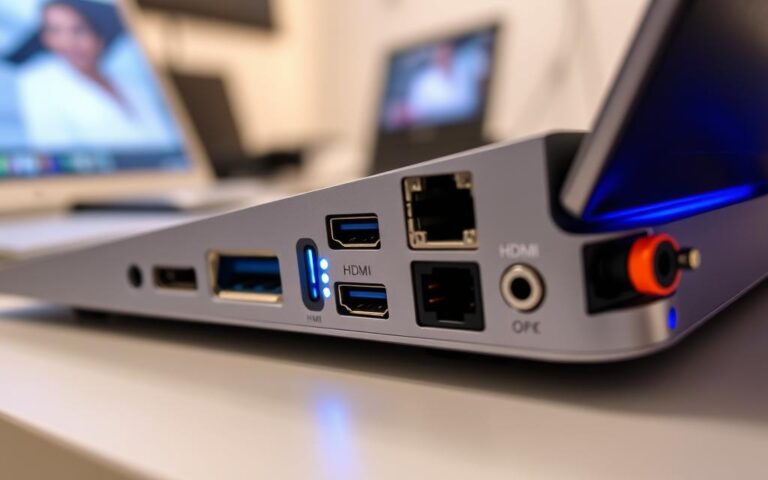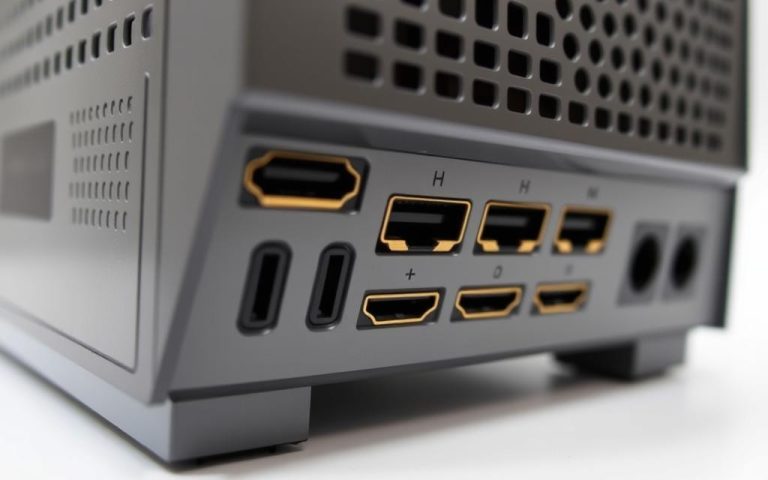Determining Port Numbers on Your Computer
Port numbers are key for anyone involved in computer networking. They range from 0 to 65,535, working like extensions of an IP address. This helps different applications to talk to each other at the same time. Ports are split into types: well-known ports, registered ports, and dynamic ports. Each has its use. For instance, port 80 is for HTTP, and port 443 is for secure HTTPS.
To better secure your network and boost connectivity, it’s crucial to know how to manage port numbers. TCP and UDP are tools that help with data reliability or speed, depending on the need. Understanding and controlling port numbers keep your computer safe from threats. It also helps applications run better.
Understanding Port Numbers
Port numbers are key to internet communications, acting like digital labels. They ensure data goes to the right service on a server. Each device connected to the network has specific ports for standard protocols. This makes apps work smoothly together.
Definition of a Port Number
A port number is essential for directing network messages. For example, HTTP messages usually go to port 80. FTP uses ports 20 and 21. They are like apartment numbers, sorting internet traffic to the right IP address. This system keeps internet communications efficient.
Types of Ports
There are three main kinds of ports to know about:
- Well-known ports (0-1023): Reserved for important applications, like 80 for HTTP.
- Registered ports (1024-49151): These ports are for specific services by different organisations.
- Dynamic ports (49152-65535): Used temporarily by any app, these ports add flexibility in device communication.
It’s important to understand these types for managing network traffic and ensuring right communication protocols.
| Category | Port Range | Typical Uses |
|---|---|---|
| Well-known ports | 0 – 1023 | HTTP (80), FTP (20, 21), SMTP (25) |
| Registered ports | 1024 – 49151 | Assigned by organisations for specific services |
| Dynamic/Private ports | 49152 – 65536 | Temporary use by applications |
Importance of Knowing Your Port Numbers
Understanding port numbers is key to good network management and safety. There are 1 to 65,535 ports available. Knowing these helps improve how well things work while keeping ports safe.
Improving Security
Managing port numbers well is important for better security. The first 1023 ports are for important services and big companies. Ports from 1024 to 49151 are for specific programs. Keeping some ports closed is vital to stop hackers. Setting up firewalls properly can help.
Watching what happens on your ports is a must. This stops unwelcome attempts to get your data. It makes your network safer.
Optimising Connectivity
Finding the right port numbers helps make connections better. Some programs need certain ports open to work their best. Using port forwarding can improve how devices talk to each other. This is great for gaming or watching videos online. It makes things run smoother and faster.
Choosing the right resources for different needs makes your network better. It lets you adjust and grow your setup as needed. This makes sure everything runs well together.

How do I know the port number of my computer?
Knowing your computer’s port numbers can improve how you manage your network and its security. Each operating system uses special commands for this.
Finding Ports on Windows
For Windows, the Command Prompt is your best friend. Here, you can run commands to see active ports and their conditions. Just follow these steps to get the info you need:
- Press Windows Key + S, type “cmd”, and press Enter.
- Input the command netstat -a to show all active ports.
With this command, you get to see which ports are in use. It shows their IP addresses under the Local Address column too.
If you want more details, try the netstat -ab command. It lists applications and their ports. For even more info, NirSoft CurrPorts is a handy tool. It provides detailed port information, helpful for managing and monitoring them.
Finding Ports on macOS
macOS users also use Terminal commands, much like Windows Command Prompt. Follow these steps to find your macOS port numbers:
- Press Command + Spacebar, type “terminal” and press Enter.
- Type the command netstat -an in the Terminal.
This gives you a complete list of all ports and their states. It helps you identify which ports are open and listening for connections.
Understanding how to find port numbers on both Windows and macOS helps in network management and security. It lets users solve network issues and avoid potential conflicts.
How to Open and Close Ports on Your Computer
It’s important to handle open ports well for better connectivity and safety. There are ways to open and close ports on Windows and macOS. Here, you’ll learn how to manage ports right.
Opening Ports on Windows
For Windows, adjust Windows Firewall to open ports. This helps with better port setup:
- Access the Control Panel.
- Navigate to “System and Security” and choose “Windows Defender Firewall.”
- Click on “Advanced settings,” then “Inbound Rules.”
- Right-click, select “New Rule,” and pick “Port.”
- Decide on TCP or UDP ports and type the port number.
- Complete the steps to allow the connection.
This method helps fix connectivity issues or enable apps to work well. For more on closing ports with tools like Netstat and Taskkill, check here.
Opening Ports on macOS
For macOS, opening ports is straightforward and keeps macOS security strong:
- Go to “System Preferences.”
- Click “Security and Privacy” > “Firewall.”
- Press “Firewall Options” and tap the plus to add an app.
- Make sure “Allow Incoming Connections” is ticked off.
Advanced port checks on macOS can use Terminal commands like netstat -nr | grep default to find IP addresses. The nc -vz command checks if a port is open. This keeps apps working smoothly while staying secure.
If you need more details, canyouseeme.org is great for checking open port status on different systems.
| System | Method | Primary Tool |
|---|---|---|
| Windows | Windows Firewall adjustments | Windows Defender Firewall |
| macOS | System Preferences adjustments | System Preferences |
| Both | External Port Check | canyouseeme.org |
Conclusion
Understanding how to manage port numbers is key for improving your computer’s network. There are 65,535 TCP and UDP ports. They are split into well-known, registered, and dynamic ports. It’s vital to know which ports are open and how to handle them right.
Knowing about port numbers helps make better connections and increases security. Unchecked open ports can let in malware, letting hackers attack. This can put your personal data at risk. So, it’s very important to keep an eye on and control these ports.
Tools like Netstat and Nmap are great for checking and managing your ports. They help you find and stop any risky activity fast. Scanning ports often can block malware and stop hackers from getting in. To learn more about ports, look at detailed resources like this article on computer port management.
FAQ
What is a port number and its function in networking?
A port number helps computers connect to the internet. It identifies specific applications or processes to send network messages. This allows many connections through just one IP address.
What are the main categories of port numbers?
Port numbers fall into three groups. Well-known ports are numbers 0-1023 used for big applications like the web (80) and sending files (20). Registered ports (1024-49151) are for services that have registered for them. Dynamic or private ports (49152-65535) are for any app’s temporary needs.
How can knowing port numbers improve network security?
By knowing your port numbers, you can better control your network’s security. You can keep an eye on which ports are open. This helps prevent hackers from finding a way into your network.
How do I find port numbers on my Windows computer?
On a Windows PC, use the Command Prompt to find ports. Press Windows Key + S, type “cmd”, and hit Enter. Type `netstat -a` in the prompt. You’ll see a list of active ports and their status.
What are the steps to find port numbers on macOS?
For macOS, open Terminal by pressing Command + Spacebar. Type “terminal” and hit Enter. Then, type `netstat -an` to see ports and their status. This shows which ports are in use.
How can I open or close ports on a Windows computer?
On Windows, go to the Control Panel and find “System and Security”. Choose “Windows Defender Firewall”, then “Advanced settings.” You can make a new rule to open or close ports by choosing TCP or UDP and the port number.
What steps do I need to take to open ports on macOS?
For macOS, head to “System Preferences” and click “Security and Privacy.” Then “Firewall,” and “Firewall Options.” Tap the plus sign to add an app. Make sure “Allow Incoming Connections” is selected to open the port.
Why is it important to manage port numbers effectively?
Managing port numbers well is key for good connectivity and security. It makes streaming or gaming better. It also keeps your network safe from cyber threats.















